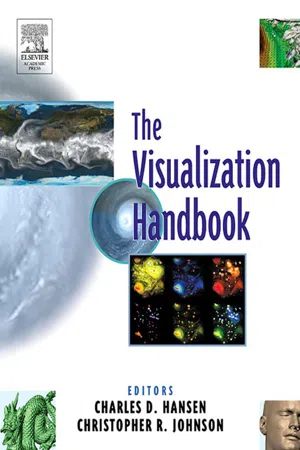1.1 Introduction
In this chapter, we look at basic algorithms for scientific visualization. In practice, a typical algorithm can be thought of as a transformation from one data form into another. These operations may also change the dimensionality of the data. For example, generating a streamline from a specification of a starting point in an input 3D dataset produces a 1D curve. The input may be represented as a finite element mesh, while the output may be represented as a polyline. Such operations are typical of scientific visualization systems that repeatedly transform data into different forms and ultimately transform it into a representation that can be rendered by the computer system.
The algorithms that transform data are the heart of data visualization. To describe the various transformations available, we need to categorize algorithms according to the structure and type of transformation. By structure, we mean the effects that transformation has on the topology and geometry of the dataset. By type, we mean the type of dataset that the algorithm operates on.
Structural transformations can be classified in four ways, depending on how they affect the geometry, topology, and attributes of a dataset. Here, we consider the topology of the dataset as the relationship of discrete data samples (one to another) that are invariant with respect to geometric transformation. For example, a regular, axis-aligned sampling of data in three dimensions is referred to as a volume, and its topology is a rectangular (structured) lattice with clearly defined neighborhood voxels and samples. On the other hand, the topology of a finite element mesh is represented by an (unstructured) list of elements, each defined by an ordered list of points. Geometry is a specification of the topology in space (typically 3D), including point coordinates and interpolation functions. Attributes are data associated with the topology and/or geometry of the dataset, such as temperature, pressure, or velocity. Attributes are typically categorized as being scalars (single value per sample), vectors (n-vector of values), tensor (matrix), surface normals, texture coordinates, or general field data. Given these terms, the following transformations are typical of scientific visualization systems:
• Geometric transformations alter input geometry but do not change the topology of the dataset. For example, if we translate, rotate, and/or scale the points of a polygonal dataset, the topology does not change, but the point coordinates, and therefore the geometry, do.
• Topological transformations alter input topology but do not change geometry and attribute data. Converting a dataset type from polygonal to unstructured grid, or from image to unstructured grid, changes the topology but not the geometry. More often, however, the geometry changes whenever the topology does, so topological transformation is uncommon.
• Attribute transformations convert data attributes from one form to another, or create new attributes from the input data. The structure of the dataset remains unaffected. Computing vector magnitude and creating scalars based on elevation are data attribute transformations.
• Combined transformations change both dataset structure and attribute data. For example, computing contour lines or surfaces is a combined transformation.
We also may classify algorithms according to the type of data they operate on. The meaning of the word “type” is often somewhat vague. Typically, “type” means the type of attribute data, such as scalars or vectors. These categories include the following:
• Scalar algorithms operate on scalar data. An example is the generation of contour lines of temperature on a weather map.
• Vector algorithms operate on vector data. Showing oriented arrows of airflow (direction and magnitude) is an example of vector visualization.
• Tensor algorithms operate on tensor matrices. One example of a tensor algorithm is to show the components of stress or strain in a material using oriented icons.
• Modeling algorithms generate dataset topology or geometry, or surface normals or texture data. “Modeling algorithms” tends to be the catch-all category for algorithms that do not fit neatly into any single category mentioned above. For example, generating glyphs oriented according to the vector direction and then scaled according to the scalar value is a combined scalar/vector algorithm. For convenience, we classify such an algorithm as a modeling algorithm because it does not fit squarely into any other category.
Note that an alternative classification scheme is to refer to the topological type of the input data (e.g., image, volume, or unstructured mesh) that a particular algorithm operates on. In the remainder of the chapter we will classify the type of the algorithm as the type of attribute data on which it operates. Be forewarned, though, that alternative classification schemes do exist and may be better suited to describing the true nature of the algorithm.
1.1.1 Generality Vs. Efficiency
Most algorithms can be implemented specifically for a particular data type or, more generally, for treating any data type. The advantage of a specific algorithm is that it is usually faster than a comparable general algorithm. An implementation of a specific algorithm may also be more memory-efficient, and it may better reflect the relationship between the algorithm and the dataset type it operates on.
One example of this is conto...
